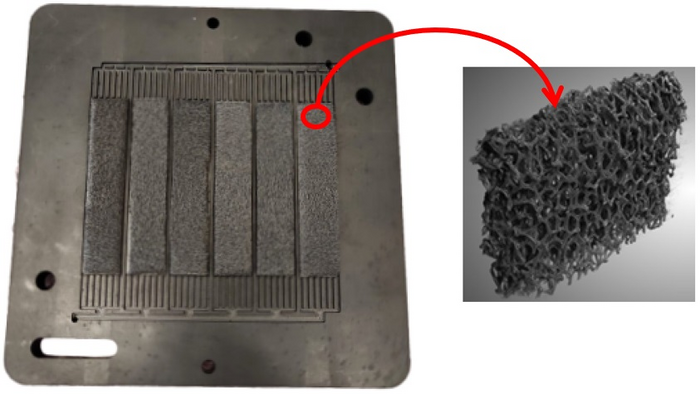Researchers at the University of Sevilla in Spain have developed a proton exchange membrane fuel cell (PEMFC) with a bipolar plate (BP) based on a nature-inspired structure. According to the scientists, BPs are crucial for optimal water management within the cell, which prevents flooding and improves the cell operation at high current densities. “A properly optimized flow design allows the fuel cell to develop uniform and stable power output and correctly manage spin-off water from the reaction,” they stated.
Through computational fluid dynamics (CFD) models and simulations, the Spanish group investigated several bioinspired flow channel structures such as leaves, lungs, or sponges and sought to assess which of them offer the best performance in terms of reactant distribution, pressure, and velocity fields.
The academics created three different flow channel architectures. The first one, named Design A, is symmetric with respect to the BP diagonal and consists of a branch going along the BP diagonal with ramified secondary branches in a perpendicular direction, which in turn are linked via tertiary perpendicular branches. The second flow channel configuration, called Design B, consists of a double serpentine flow channel with a continuous flow from inlet to outlet and a geometrical symmetry with respect to the main BP diagonal. The Design C architecture is based on an inlet collector and an outlet collector connected in parallel with six groups of straight channels in sets of seven channels each.
The performance of the three architectures was compared to that of a reference design with a parallel-serpentine design of 50 cm2 active area from US-based ElectroChem Inc. “The experimental work was conducted with a PEM fuel cell test station, devoted to the experimental testing of PEM single cells and short stacks up to 500 W,” the researchers said.
A slightly modified version of Design C including graphene porous sponge inserts was the architecture with the best performance. It exhibited the most homogeneous velocity flow field, an average velocity of 1.71 m/s), a standard deviation velocity of 2.87 m/s, and a lower pressure drop of 1042.8 Pa.
“Even though lower performance was observed for the biomimetic design in comparison to the parallel-serpentine for lower cell temperatures (4.1% lower), higher cell backpressure (6.2% lower) and higher cathode stoichiometric factor of 3.5 (21.2% lower), the novel biomimetic design showed a better performance when operating at higher relative humidity values of 90%, reaching out a peak power a 6.0% higher, indicating that the proposed novel biomimetic design is particularly suited for improved water management at high reactants humidity,” the academics concluded.
Their findings were presented in the paper Experimental and numerical Investigation on the design of a bioinspired PEM fuel cell, published in Energy.
This content is protected by copyright and may not be reused. If you want to cooperate with us and would like to reuse some of our content, please contact: editors@pv-magazine.com.




By submitting this form you agree to pv magazine using your data for the purposes of publishing your comment.
Your personal data will only be disclosed or otherwise transmitted to third parties for the purposes of spam filtering or if this is necessary for technical maintenance of the website. Any other transfer to third parties will not take place unless this is justified on the basis of applicable data protection regulations or if pv magazine is legally obliged to do so.
You may revoke this consent at any time with effect for the future, in which case your personal data will be deleted immediately. Otherwise, your data will be deleted if pv magazine has processed your request or the purpose of data storage is fulfilled.
Further information on data privacy can be found in our Data Protection Policy.